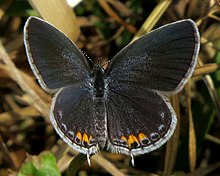The brilliant creature below joins me on the porch.....it will fly about and land on me and sit and gently flutter it's wings for long minutes at a time. It really is rather friendly, if I am very slow and gentle, I can touch a wing as it perches upon my leg or arm and it does not fly away...
AMAZING!
It has a soft, silky texture to it's wing.
There are three or four of them that I see flitting about....another thing to love!

The Spicebush Swallowtail(Papilio troilus) is a *common black swallowtail butterflyfound in North America, also known as the Green-Clouded butterfly.[1] It has two subspecies, Papilio troilus troilus and Papilio troilus ilioneus, the latter found mainly in the Florida peninsula.[2] The spicebush swallowtail derives its name from its most common host plant, the spicebush, members of the genus Lindera.
The family to which Spicebush Swallowtails belong,Papilionidae, or swallowtails, include the largest butterflies in the world. The swallowtails are unique in that even while feeding, they continue to flutter their wings. Unlike other swallowtail butterflies, Spicebushes fly low to the ground instead of at great heights.[
Distribution and habitat[edit]
The Spicebush Swallowtail is found only in the eastern US and southern Ontario, but occasionally strays as far as the American Midwest, Cuba, Manitoba and Colorado.[3] While still larvae, Spicebush Swallowtail remain on the leaf of the plant on which they were laid. As adults, the butterflies do not limit their flight geographically and instead are motivated mostly by availability of water and nectar and mates within the species’ range.[4]
This primarily black swallowtail is normally found in deciduous woods or woody swamps, where they can be found flying low and fast through shaded areas. Females tend to stay in open plains,[5] while males are typically found in swamp areas.[4]
Papilio troilus troilus[edit]
The more widespread subspecies of Spicebush Swallowtail is prevalent throughout the Eastern United States, from New England to Wisconsin, west to Illinois, Wisconsin, North Dakota and Nebraska. It also abounds in Texas and Colorado.[6] Temperature may be a limiting factor for the spread of P. troilus troilus, as in experimental conditions, they do not fare well at or above 36 °C nor are they capable of flourishing at or below 14 °C.[7]
Papilio troilus ilioneus[edit]
The smaller subspecies of P. troilus is confined to the Southeastern coastal United States, namely throughout Florida and along coastal Georgia and in places in Texas.[6]
Description[edit]
On the underside of the hindwing, there will be a dual row of orange spots, which distinguishes it from the pipevine swallowtail, which only has a single row of spots. In between these rows, there is more blue or green coloring.[6]
Information found at ---->>> Spicebush Swallowtail
*Guess it goes to show, something "common" can be quite beautiful indeed!
We also have these little guys and gals. Lucy likes to chase them...It is absolutely the cutest thing watching her run around the yard after these little blue butterflies.
Eastern tailed-blue
From Wikipedia, the free encyclopedia
| Eastern Tailed-blue | |
|---|---|
 | |
| Male | |
 | |
| Female | |
Common
| |
| Scientific classification | |
| Kingdom: | Animalia |
| Phylum: | Arthropoda |
| Class: | Insecta |
| Order: | Lepidoptera |
| Family: | Lycaenidae |
| Genus: | Cupido |
| Species: | C. comyntas |
| Binomial name | |
| Cupido comyntas (Godart, [1824]) | |
| Synonyms | |
The eastern tailed-blue oreastern tailed blue (Cupido comyntas), also known asEveres comyntas,[2] is a *common
butterfly of easternNorth America. It is a medium-sized butterfly that is distinguished from other blues in its range by the small thin tail.[3]
Description[edit]
Males are generally blue on the upperside of their wings while females are lighter blue to brown or charcoal in coloring, but there are also varieties of purple and pink found in both sexes.[4] The underside coloration ranges from bluish-white to tan. There are two or three (outermost one often faint) black to orange chevron-shaped spots on the rear of the hind wings and a trailing tail off the innermost of the spots. The butterfly is 21 to 29 mm (0.83 to 1.14 in) wide with wings outstretched and slightly shorter in length.[5]
Eastern tailed-blues feed on various legumes and are known to secrete a substance which is favored by some ant species. The ant in turn protects the larva of the butterfly from other predators.
Range[edit]
The butterfly is common across eastern North America, and is found as far south asCentral America. The Great Plains form a habitat boundary between the Eastern and the much less common but similarwestern tailed-blue butterfly. The central section ofCalifornia and portions of the states of Oregon andWashington also has eastern tailed blues, which likely adapted to the habitat after being brought there inadvertently by man. The species is virtually absent from the Rocky Mountain region. Often found in sunny, open habitat.[4]




2 comments:
Flutterbys only land on you if you are special. Obviously, you are.
Awww, thank you. ; )
Post a Comment